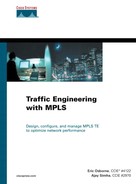Introduction
This book concentrates on real-world usage of MPLS TE. We spend most of our time discussing things you can configure, tools you can use to troubleshoot and manage MPLS TE, and design scenarios.
This is not an introduction to MPLS. There's enough literature out there, both Cisco and non-Cisco, that we didn't feel the need to spend time on an MPLS introduction. Although Chapter 2 reviews the basics, we generally assume that you're familiar with the three basic label operations (push, pop, and swap) and how an MPLS packet is forwarded through a network. But as soon as you're past that point, this book is for you.
You might already be using MPLS TE in your network. If so, this book is also for you. This book has many details that we hope will be useful as you continue to use and explore MPLS TE.
Or perhaps you are designing a new backbone and are considering MPLS TE for use in your network. If so, this book is also for you as well. Not only do you need to understand the protocol mechanisms to properly design a network, you also need to understand the ramifications of your design choices.
Who Should Read This Book?
Everybody! You, your friends, your grandmother, her knitting-circle friends, your kids, and their kindergarten classmates—everybody! Actually, we're not so much concerned with who reads this book as with who buys it, but to ask you to buy it and not read it is pretty crass.
In all seriousness, this book is for two kinds of people:
Network engineers— Those whose job it is to configure, troubleshoot, and manage a network
Network architects— Those who design networks to carry different types of traffic (voice and data) and support service-level agreements (SLAs)
We have friends who, in their respective jobs, fill both roles. To them, and to you if you do the same, we say, “Great! Buy two copies of this book!”
How This Book Is Organized
This book is designed to be read either cover-to-cover or chapter-by-chapter. It divides roughly into four parts:
Chapters 1 and 2 discuss the history, motivation, and basic operation of MPLS and MPLS TE.
Chapters 3, 4 and 5 cover the basic processes used to set up and build TE tunnels on your network.
Chapters 6 and 7 cover advanced MPLS TE applications: MPLS TE and QoS, and protection using Fast Reroute (FRR).
Chapters 8, 9, 10 and 11 cover network management, design, deployment, and troubleshooting—things you need to understand to be able to apply MPLS TE in the real world.
Here are the details on each chapter:
Chapter 1, “Understanding Traffic Engineering with MPLS”— This chapter discusses the history of basic data networks and the motivation for MPLS and MPLS TE as the next step in the evolution of networks.
Chapter 2, “MPLS Forwarding Basics”— This chapter is a quick review of how MPLS forwarding works. Although this book is not an introduction to MPLS, you might find it beneficial to brush up on some of the details, and that's what this chapter provides.
Chapter 3, “Information Distribution”— This chapter begins the series of three chapters that are really the core of this book. The protocols and mechanisms of MPLS TE have three parts, and the first is distributing MPLS TE information in your IGP.
Chapter 4, “Path Calculation and Setup”— This chapter is the second of the three core chapters. It covers what is done with information after it has been distributed by your IGP. The two prominent pieces covered in this chapter are Constrained SPF (CSPF) and Resource Reservation Protocol (RSVP).
Chapter 5, “Forwarding Traffic Down Tunnels”— This chapter is the last of the three core chapters. It covers what is done with TE tunnels after they are set up. This chapter covers load sharing in various scenarios, announcing TE tunnels into your IGP as a forwarding adjacency, and automatic tunnel bandwidth adjustment using a Cisco mechanism called auto bandwidth.
Chapter 6, “Quality of Service with MPLS TE”— This chapter covers the integration of MPLS and MPLS TE with the DiffServ architecture. It also covers DiffServ-Aware Traffic Engineering (DS-TE).
Chapter 7, “Protection and Restoration”— This chapter covers various traffic protection and restoration mechanisms under the umbrella of Cisco's FRR—how to configure these services, how they work, and how to greatly reduce your packet loss in the event of a failure in your network.
Chapter 8, “MPLS TE Management”— This chapter covers tools and mechanisms for managing an MPLS TE network.
Chapter 9, “Network Design with MPLS TE”— This chapter predominantly covers scalability. It looks at different ways to deloy MPLS TE on your network, and how the various solutions scale as they grow.
Chapter 10, “MPLS TE Deployment Tips”— This chapter covers various knobs, best practices, and case studies that relate to deploying MPLS TE on your network.
Chapter 11, “Troubleshooting MPLS TE”— This chapter discusses tools and techniques for troubleshooting MPLS TE on an operational network.
Two appendixes are also provided. Appendix A lists all the major commands that are relevant to MPLS TE. Appendix B lists resources such as URLs and other books. Appendix B is also available at www.ciscopress.com/1587050315.
